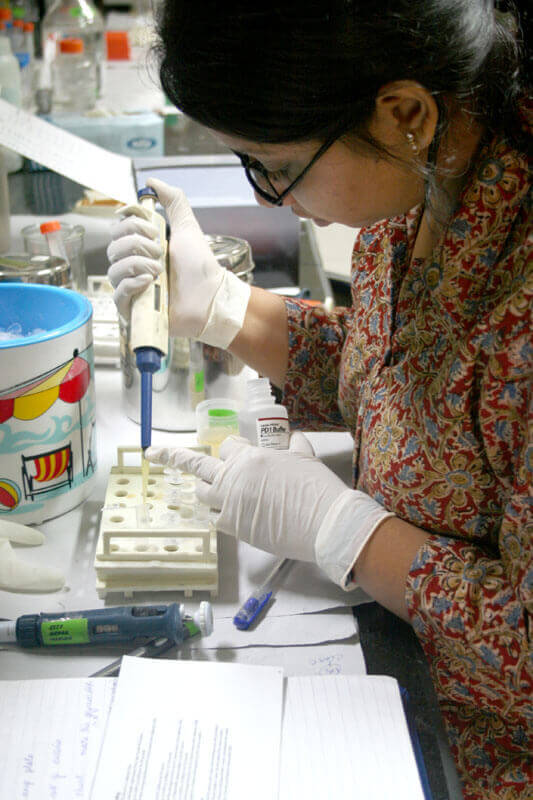Courtney CarsonGHTC
Courtney Carson is a policy and advocacy officer at GHTC, who leads GHTC's US advocacy portfolio.
 A laboratory technician. Photo: PATH/Satvir MalhotraThe United States leads the world in research and development (R&D) for rare and neglected diseases, but we still need to take action to unlock scientific
potential and accelerate the development of urgently needed drugs, vaccines, diagnostics, and other health tools. This message of leadership and potential
long championed by GHTC was shared by President Trump in his first address to Congress on February 28th when he told the story of Megan Crowley, a
twenty-year-old college student who, despite being diagnosed as an infant with Pompe Disease, a rare and incurable genetic disorder, is alive today
thanks to innovative R&D that yielded an effective treatment.
A laboratory technician. Photo: PATH/Satvir MalhotraThe United States leads the world in research and development (R&D) for rare and neglected diseases, but we still need to take action to unlock scientific
potential and accelerate the development of urgently needed drugs, vaccines, diagnostics, and other health tools. This message of leadership and potential
long championed by GHTC was shared by President Trump in his first address to Congress on February 28th when he told the story of Megan Crowley, a
twenty-year-old college student who, despite being diagnosed as an infant with Pompe Disease, a rare and incurable genetic disorder, is alive today
thanks to innovative R&D that yielded an effective treatment.
US leadership in medical and global health research has a tremendous track record of delivering new and innovative technologies for rare and neglected diseases that save lives in the United States and around the world. Scientists at the National Institutes of Health (NIH) first identified the HIV virus as the cause of AIDS and led the development of the first antiretroviral drugs. An estimated 14.4 million life-years collectively have been gained through the use of NIH supported HIV and AIDS therapies since 1995. US research supported the development of the GeneXpert diagnostic test for tuberculosis (TB)—the first test to rapidly diagnose drug-resistant and extensively drug-resistant TB, poised to be one of the world’s greatest infectious disease threats. USAID supported the development of Coartem Dispersible—the first artemisinin-based combination therapy specifically dosed for children, making malaria treatment safe and effective for all ages. President Trump is right: with a commitment to harnessing American innovation and ingenuity, “cures to illnesses that have always plagued us are not too much to hope.”
"Cures to illnesses that have always plagued us are not too much to hope.”—President Donald Trump
To achieve this goal, however, we must look at all the components that drive global health R&D. In his speech, President Trump identified regulatory processes as a primary barrier to innovation and access to new medicines, but there are other factors that must be considered. While there may be ways to streamline regulatory review to accelerate access to life-saving innovations, we ultimately want to advance American leadership in R&D that delivers safe, effective, and rigorously reviewed treatments for neglected diseases and conditions. This cannot be achieved by reducing regulations alone.
First and foremost, sustainable, predictable funding is critical. It takes years of research and a reliable flow of resources to develop new drugs, vaccines, and other health tools. We cannot address rare and neglected diseases effectively with cuts to medical research funding, dramatic ebbs and flows in discretionary spending, or by relying on emergency allocations of R&D resources during a crisis. Indeed, one of the crucial successes in the search for treatment for Pompe Disease was the mobilization of US$100 million for research. The US government has the power to unlock scientific potential and catalyze R&D through dedicated funding, and support for partnerships that leverage government, private sector, nonprofit, and other donor funding.
We also must recognize that that diseases do not respect borders, and investments that help diagnose, treat, and eliminate diseases overseas are investments that benefit the United States along with the rest of the world.
We also must recognize that that diseases do not respect borders, and investments that help diagnose, treat, and eliminate diseases overseas are investments that benefit the United States along with the rest of the world. In fact, investing to address disease threats before they reach the United States is more efficient and cost-effective—and saves more lives—than waiting until diseases reach our shores to invest. This means that the entire world must be equipped with the necessary tools to address emerging and longstanding threats, no matter where they are. The United States can lead the world toward President Trump’s vision of accelerating cures for diseases that have plagued humanity, but not if we retreat from international engagement and development efforts—including strong engagement in global health R&D.
The United States can lead the world toward President Trump’s vision of accelerating cures for diseases that have plagued humanity, but not if we retreat from international engagement and development efforts—including strong engagement in global health R&D.
We share the same goal: to harness American innovation to strengthen US leadership in health R&D, keep American people safe from rare, neglected, and longstanding disease threats, and make sure that people around the world gain access to new medical innovations as quickly as possible. There is no one silver bullet to achieve this goal. To truly commit to innovation and unlock cures for long neglected diseases, we must adopt a holistic view and ensure that US support for innovation and R&D—including funding—remains strong and robust.